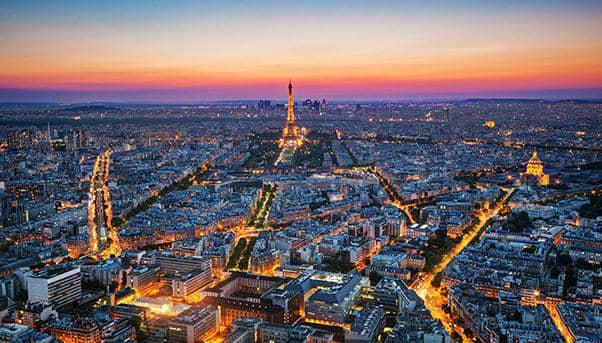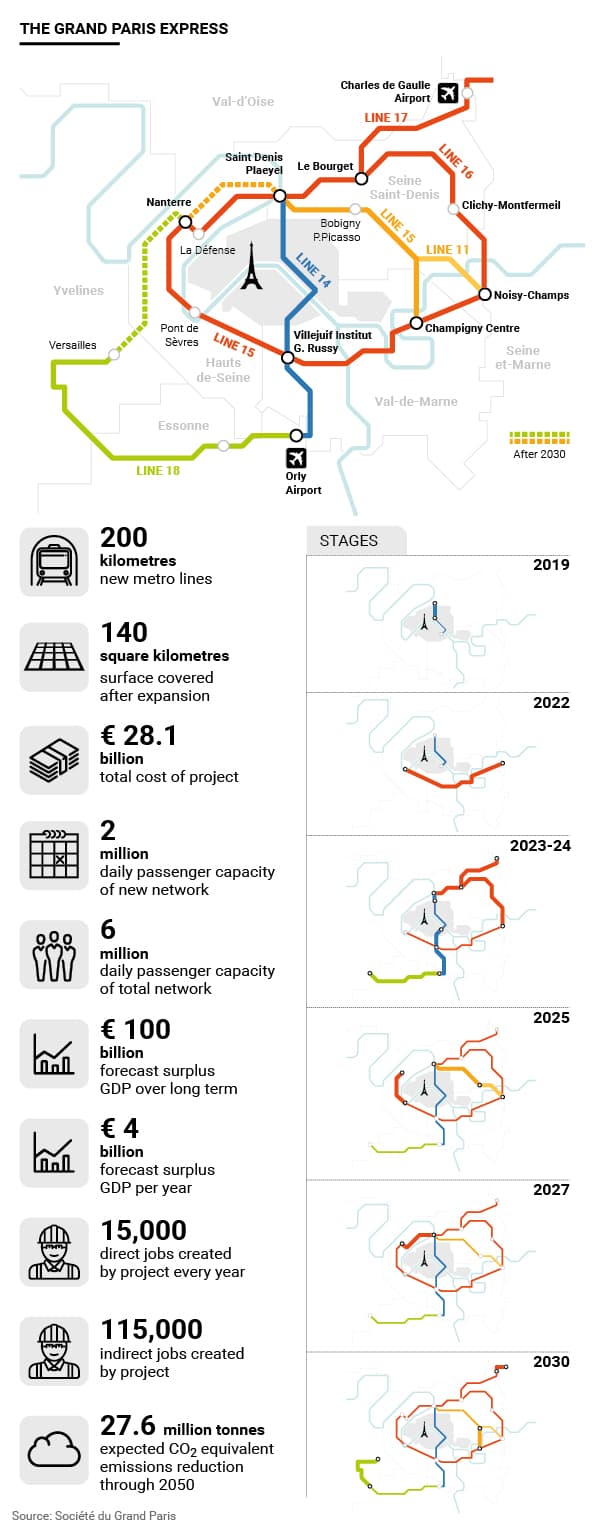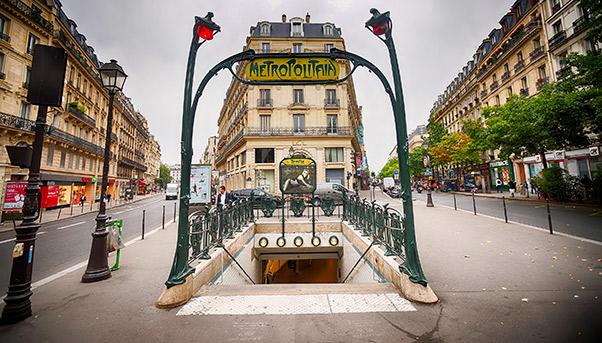
Uniting Paris with Île-de-France with 200 kilometres of new metro lines to link every corner of the city and region and their 12 million residents who are responsible for 30% of the gross domestic product (GDP) of France. That is the objective of the Grand Paris Express, a project so ambitious that only a few others in the world can match it in scale. Indeed, its construction foresees an investment of €24.7 billion, a total that reaches €28.1 billion when related works are taken into account. Subsequent property development by private investors in the outlying areas to be covered by the project could bring the total to up to €40 billion. It is funded mainly by public entities, such as the French investment group Caisse des Dépôts et Consignations, the city and regional governments, as well as the European Investment Bank (EIB) with a €1 billion commitment.
It is a massive investment that will allow outlying areas to be linked to Paris via a network of new and extended metro and rail lines that integrate the various transport systems and modernize mobility throughout the French capital. «The Grand Paris Express is comparable to the great works of Haussmann and Fulgence Bienvenüe of the 19th Century», reads a recent statement by Philippe Yvin of Société du Grand Paris, the public entity overseeing the project. «The project aims to double the region’s metro network in at least 15 years, going from 200 to 400 km. The Grand Paris Express has no rival in the world with the exception of the Riyadh metro in Saudi Arabia and in China», it adds. «This ultra-modern and connected automatic metro network…is the lever that will give metropolitan Paris the means to invent itself in the future, a more inclusive region, anchored in sustainable development and in line with the new means of living and technology».
The Project

The idea behind the Grand Paris Express, the details of which were first presented in 2008, is to expand the already extensive urban transport network, lengthening some lines and building new ones with the aim of connecting the entire region of Île-de-France including Paris and serve an additional six million people in the periphery. This is being done by extending four lines (numbered 4, 11, 12 and 14) and building four new ones that will have driverless trains (numbered 15, 16, 17 and 18). Among the new lines, the 15 will be the ring that circles Paris. The others will link the city with outlying areas. Once the project is complete, expected by 2030, there will be 200 new kilometres of lines and 77 new stations where a very efficient transport system will have driverless trains pass every two to three minutes on average. On occasion, they will be able to arrive at a much faster interval of 90 seconds.
Work began this year, with a focus on the extension of Line 14 near of Saint-Lazare station, the second most congested on the Paris metro. According to the timeline established by the developers, by 2018 the line will be able to guarantee the passage of new trains with eight instead of six cars, increasing capacity to 40,000 passengers every hour. Once the Grand Paris Express is complete, it will be able to transport an additional two million passengers a day, bringing the total number to about six million on the entire network.
The Impact of the Opera
One of the first visible signs of the impact that it will have on the region will be economic. In a document published May 10 entitled “Du projet à la réalité: le métro du Grand Paris et ses impacts”, the Société du Grand Paris expected the project to generate for the region a long-term GDP surplus equal to €100 billion, with an average of €4 billion a year. The first to benefit will certainly be the workers, direct and indirect. Through to 2025, 15,000 direct jobs are expected to be created, while the Société du Grand Paris forecasts it creating another 115,000 in indirect jobs. There is also a social element to this project, since one of the missions of the Grand Paris Express is to unite a region to encourage social development by helping people who are marginalized. The new network will cover an urban area of 140 square kilometres – one and a half times that of Paris. By doing this, it will reach neighbourhoods that were once isolated and served by obsolete and inconvenient public transport. It is also expected to encourage the construction of more affordable housing for people who cannot sustain the high cost of living in city proper.

The most exemplary case is perhaps Seine-Saint-Denis, the poorest of the 96 French departments with a high percentage of foreign residents. Thanks to the Grand Paris Express, it will be served by an efficient metro system. The city of Saint-Denis will have the biggest of the new stations, serving an expected 250,000 passengers every day. Meanwhile the residents of Clichy-sous-Bois, the neighbourhood that witnessed violent protests in 2005, will be able to reach downtown Paris in just 45 minutes. Société du Grand Paris says it is all part of the aim to improve integration and remain faithful to the ideals that inspired the construction of the first metro line in Paris, inaugurated in 1900 for the World’s Fair. Observing its impact on the city in 1904, writer Jules Romains described the new transport system as a “fluid cement that will bind men together”.
The Reduction in Traffic and the Protection of the Enviroment
The protection of the environment and the reduction in traffic are certainly two of the reasons that encouraged the French authorities, beginning with President Francois Hollande, to support the project. Just the extension of Line 14, which should be finished in 2019, will guarantee a reduction in passenger traffic equal to 25% on Line 13, which is one of the most congested at peak commuting times. Some 150,000 more passengers will eventually join the 550,000 who already travel along Line 14 every day. What is more, the new lines will contribute to a net reduction in vehicle traffic, with evident impact on air pollution. The Société du Grand Paris indicates that, by 2050, CO2 equivalent emissions will have fallen by an accumulated 27.6 million of tonnes. There will also be a visible reduction in congestion along the underground network of some 20%. All of this will contribute to the birth of a Greater Paris, an urban metropolis that stretches beyond the confines of the city, offering its residents the means to grow economically and lead better lives.

